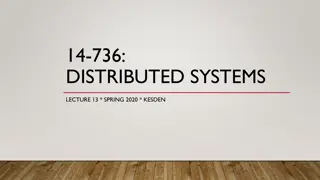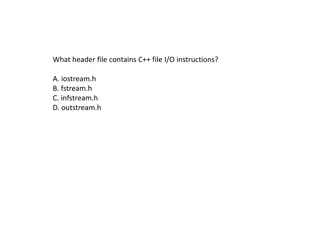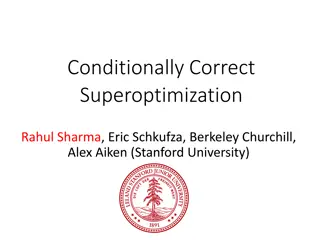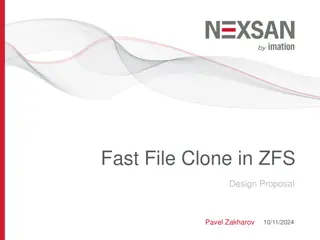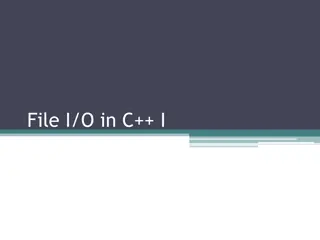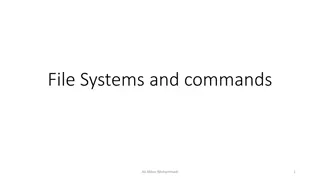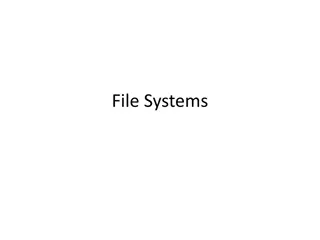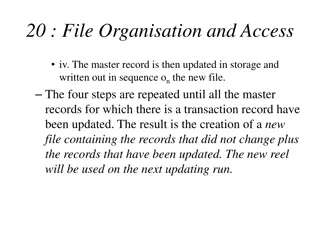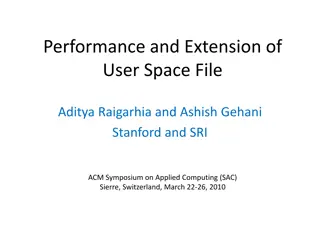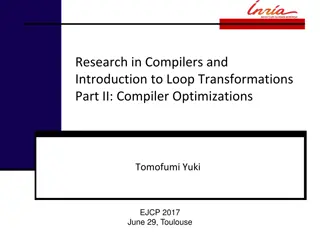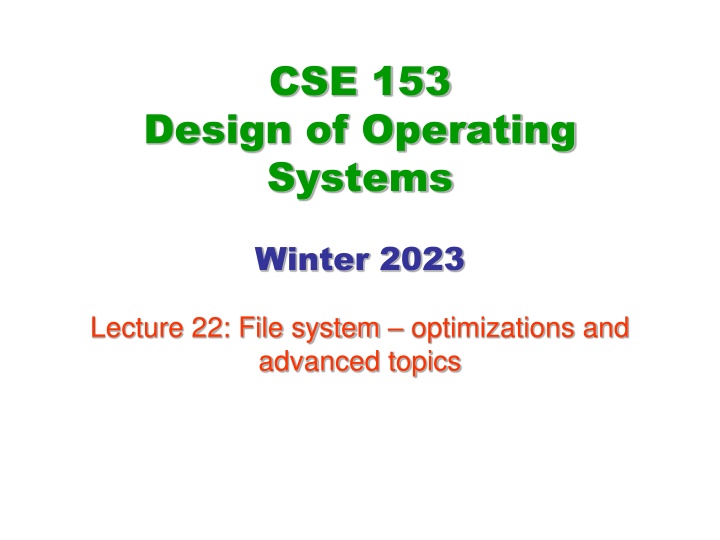
File System Optimizations and Performance Enhancements
Advanced file system optimization techniques in operating systems, including caching strategies, write-behind methods, read-ahead approaches, and more. Learn about the file buffer cache, improving disk read/write speeds, and enhancing the performance and reliability of disk drives.
Uploaded on | 0 Views
Download Presentation

Please find below an Image/Link to download the presentation.
The content on the website is provided AS IS for your information and personal use only. It may not be sold, licensed, or shared on other websites without obtaining consent from the author. If you encounter any issues during the download, it is possible that the publisher has removed the file from their server.
You are allowed to download the files provided on this website for personal or commercial use, subject to the condition that they are used lawfully. All files are the property of their respective owners.
The content on the website is provided AS IS for your information and personal use only. It may not be sold, licensed, or shared on other websites without obtaining consent from the author.
E N D
Presentation Transcript
CSE 153 Design of Operating Systems Winter 2023 Lecture 22: File system optimizations and advanced topics
Theres more to filesystems Standard Performance improvement techniques Alternative important File systems FFS: Unix Fast File system JFS: making File systems reliable LFS: Optimizing write performance Improve the performance/reliability of disk drives? RAID Generalizations Network file systems Distributed File systems Internet scale file systems CSE 153 Lecture 22/23 File system optimizations
Improving Performance Disk reads and writes take order of milliseconds Very slow compared to CPU and memory speeds How to speed things up? File buffer cache Cache writes Read ahead CSE 153 Lecture 22/23 File system optimizations
File Buffer Cache Applications exhibit significant locality for reading and writing files Idea: Cache file blocks in memory to capture locality This is called the file buffer cache Cache is system wide, used and shared by all processes Reading from the cache makes a disk perform like memory Even a 4 MB cache can be very effective Issues The file buffer cache competes with VM (tradeoff here) Like VM, it has limited size Need replacement algorithms again (LRU usually used) CSE 153 Lecture 22/23 File system optimizations
Caching Writes On a write, some applications assume that data makes it through the buffer cache and onto the disk As a result, writes are often slow even with caching Several ways to compensate for this write-behind Maintain a queue of uncommitted blocks Periodically flush the queue to disk Unreliable Battery backed-up RAM (NVRAM) As with write-behind, but maintain queue in NVRAM Expensive Log-structured file system Always write next block after last block written Complicated CSE 153 Lecture 22/23 File system optimizations
Read Ahead Many file systems implement read ahead FS predicts that the process will request next block FS goes ahead and requests it from the disk This can happen while the process is computing on previous block Overlap I/O with execution When the process requests block, it will be in cache Compliments the disk cache, which also is doing read ahead For sequentially accessed files can be a big win Unless blocks for the file are scattered across the disk File systems try to prevent that, though (during allocation) CSE 153 Lecture 22/23 File system optimizations
FFS, JFS, LFS, RAID Now we re going to look at some example file and storage systems BSD Unix Fast File System (FFS) Journaling File Systems (JFS) Log-structured File System (LFS) Not going to cover Redundant Array of Inexpensive Disks (RAID) CSE 153 Lecture 22/23 File system optimizations
Fast File System The original Unix file system had a simple, straightforward implementation Easy to implement and understand But very poor utilization of disk bandwidth (lots of seeking) BSD Unix folks did a redesign (mid 80s) that they called the Fast File System (FFS) Improved disk utilization, decreased response time McKusick, Joy, Leffler, and Fabry Now the FS to which all other Unix FS s are compared Good example of being device-aware for performance CSE 153 Lecture 22/23 File system optimizations
Data and Inode Placement Original Unix FS had two placement problems: 1. Data blocks allocated randomly in aging file systems Blocks for the same file allocated sequentially when FS is new As FS ages and fills, need to allocate into blocks freed up when other files are deleted Problem: Deleted files essentially randomly placed So, blocks for new files become scattered across the disk 2. Inodes allocated far from blocks All inodes at beginning of disk, far from data Traversing file name paths, manipulating files, directories requires going back and forth from inodes to data blocks Both of these problems generate many long seeks CSE 153 Lecture 22/23 File system optimizations
Cylinder Groups BSD FFS addressed these problems using the notion of a cylinder group Disk partitioned into groups of cylinders Data blocks in same file allocated in same cylinder Files in same directory allocated in same cylinder Inodes for files allocated in same cylinder as file data blocks Free space requirement To be able to allocate according to cylinder groups, the disk must have free space scattered across cylinders 10% of the disk is reserved just for this purpose Only used by root this is why df may report >100% CSE 153 Lecture 22/23 File system optimizations
Other Problems Small blocks (1K) caused two problems: Low bandwidth utilization Small max file size (function of block size) Fix: Use a larger block (4K) Very large files, only need two levels of indirection for 2^32 Problem: internal fragmentation Fix: Introduce fragments (1K pieces of a block) Problem: Media failures Replicate master block (superblock) Problem: Device oblivious Parameterize according to device characteristics CSE 153 Lecture 22/23 File system optimizations
The Results CSE 153 Lecture 22/23 File system optimizations
Problem: crash consistency Updates to data and meta data are not atomic l Consider, what happens when you delete a file Remove directory entry Remove the inode(s) Remove the data blocks Mark the free map (for all the i-node and data blocks you freed) What happens if you crash somewhere in the middle? l 1. 2. 3. 4. CSE 153 Lecture 22/23 File system optimizations
Journaling File Systems Journaling File systems make updates to a log Log plans for updates to a journal first When a crash happens you can replay the journal to restore consistency What if we crash when writing journal? Problem. Possible solution, bracket the changes Introduce checksum periodically Replay only parts where there is checksum that matches Journal choices (regular file? Special partition?) Log meta-data and data? CSE 153 Lecture 22/23 File system optimizations
Log-structured File System The Log-structured File System (LFS) was designed in response to two trends in workload and technology: 1. Disk bandwidth scaling significantly (40% a year) While seek latency is not 2. Large main memories in machines Large buffer caches Absorb large fraction of read requests Can use for writes as well Coalesce small writes into large writes LFS takes advantage of both of these to increase FS performance Rosenblum and Ousterhout (Berkeley, 1991) CSE 153 Lecture 22/23 File system optimizations
RAID Redundant Array of Inexpensive Disks (RAID) A storage system, not a file system Patterson, Katz, and Gibson (Berkeley, 1988) Idea: Use many disks in parallel to increase storage bandwidth, improve reliability Files are striped across disks Each stripe portion is read/written in parallel Bandwidth increases with more disks CSE 153 Lecture 22/23 File system optimizations
RAID CSE 153 Lecture 22/23 File system optimizations
RAID Challenges Small files (small writes less than a full stripe) Need to read entire stripe, update with small write, then write entire stripe out to disks Reliability More disks increases the chance of media failure (MTBF) Turn reliability problem into a feature Use one disk to store parity data XOR of all data blocks in stripe Can recover any data block from all others + parity block Hence redundant in name Introduces overhead, but, hey, disks are inexpensive CSE 153 Lecture 22/23 File system optimizations
RAID with parity + + + = CSE 153 Lecture 22/23 File system optimizations
RAID Levels In marketing literature, you will see RAID systems advertised as supporting different RAID Levels Here are some common levels: RAID 0: Striping Good for random access (no reliability) RAID 1: Mirroring Two disks, write data to both (expensive, 1X storage overhead) RAID 2,3 and 4: bit, byte and block level parity. Rarely used. RAID 5, 6: Floating parity Parity blocks for different stripes written to different disks No single parity disk, hence no bottleneck at that disk RAID 10 : Striping plus mirroring Higher bandwidth, but still have large overhead See this on PC RAID disk cards CSE 153 Lecture 22/23 File system optimizations
Other file system topics Network File systems (NFS) Can a file system be shared across the network The file system is on a single server, the clients access it remotely Distributed file systems: Can a file system be stored (and possibly replicated) across multiple machines What if they are geographically spread? Hadoop Distributed File System (HDFS), Google File System (GFS) File systems is an exciting research area Take cs202 if interested! CSE 153 Lecture 22/23 File system optimizations
Summary UNIX file system Indexed access to files using inodes FFS Improve performance by localizing files to cylinder groups JFS Improve reliability by logging operations in a journal LFS Improve write performance by treating disk as a log Need to clean log complicates things RAID Spread data across disks and store parity on separate disk CSE 153 Lecture 22/23 File system optimizations

